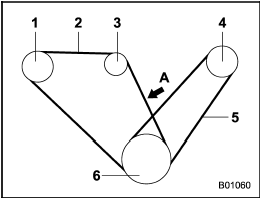Subaru Forester: Drive belts
Turbo models

Turbo models
1) Power steering oil pump pulley
2) Front side belt
3) Alternator pulley
4) Air conditioner compressor pulley
5) Rear side belt
6) Crank pulley
A) 22 lbf (98 N, 10 kgf)

The front side belt, which runs in conjunction with the following components, must be used within the specified deflection.
- Power steering oil pump pulley
- Alternator pulley
- Crank pulley
Check the deflection of the front
side belt and if there is any looseness,
cracks, wear or unusual noise
on the front side belt, contact your
SUBARU dealer.
Continuing to use the vehicle with the belt outside of the specification may cause the engine to malfunction and the above components to malfunction.
To check the deflection of the front side belt, place a straightedge (ruler) across two adjacent pulleys (alternator pulley and crank pulley) and apply a force of 22 lbf (98 N, 10 kgf) midway between the pulleys by using a spring scale. The belt deflection should be the amount specified. If the front side belt is loose, cracked or worn, contact your SUBARU dealer.

The rear side belt is a stretch-type belt, therefore the deflection does not need to be checked. If there are cracks or wear confirmed on the belts and a squeaking sound is heard from them, contact your SUBARU dealer.
Non-turbo models
It is unnecessary to check the deflection of the drive belt periodically because your engine is equipped with an automatic belt tension adjuster. However, replacement of the belt should be done according to the maintenance schedule in the “Warranty and Maintenance Booklet”. Consult your SUBARU dealer for replacement.
If the belt is loose, cracked or worn, contact your SUBARU dealer.
See also:
Heating and ventilation
There are three controls and two switches for
the heating and cooling system. They are:
1. Air flow control.
2. Fan speed control.
3. Temperature control.
4. Air intake control switch.
5. Air conditioning switch.
Fan Speed Control ( ...
Useful information
This Operator's Manual describes all models and all standard and optional equipment
of your vehicle available at the time of publication of the Operator's Manual. Country-specific
differences are possible. Please note that your vehicle ...

 Spark plugs
Spark plugs